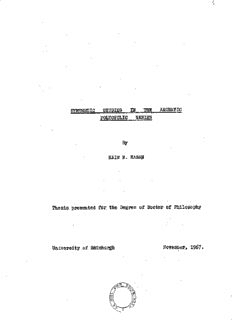Table Of Content• (cid:9) SYNTHETIC STUDIES IN THE AROMATIC
POLYcYcLIC SERIES
NA.IM M. EASAN
Thesis presented for, the Degree of Doctor of Philosophy
University of Edinburgh (cid:9) November, 1967.
a
TQ ••:g "PARENTS
CONTENTS
Z20-
(1)
Summan (cid:9)
1
Nomenclature (cid:9)
introduction
2
Fluoranthene (cid:9)
14
Fluorene
19
Naphthalene
21
Object of research
Discussion
Section 1: (cid:9) Attempted synthesis of 2,8-d.ibromo-3-
• (cid:9) methoxyfluoranthefle from fluoranthene
nucleus 22
Section 2: (cid:9) Attempted synthesis of 2 98-dibromo-3-
methoxyfluoranthene from 1-iod.o-4-methoxy-
naphthalene.
Reactivity of the 1-halogeno-nitro-naph-
38
• (cid:9) thalene
Section 3: (cid:9) Part 1. (cid:9) Synthesis of 2,8-diibz'omo-3-
me thoxyfluc ranthene from
3-bz'omo-fluorene 145
Part 2, (cid:9) Attempted synthesis of 2,8-
dibromo-3-me thoxyfluoranthene
from 2-browo-7-methoxyfluorene 55
Experimental
Introduction (cid:9) 66
Section I (cid:9) 67
' (cid:9)
Section II (cid:9) 91
Section III Part 1 (cid:9) • (cid:9) 99
Part 2 (cid:9) 122
Miscellaneous experiments (cid:9) 1146
Bibliography (cid:9) • (cid:9) • (cid:9) 150
AOlthowlëdge:ments (cid:9) • (cid:9) 157
SUMMARY
The brominatión of 3-methoxyt1uoranthne yields 2, 3-dibromo-
16
3-methoxyfluoranthene as proved by synthesis. This result is in
harmony with the results observed with other 3-substituted
fluoranthenes.
2. Various unsuccessful attempts to prepare 2-bromo-3-methoxy-
fluo.ranthene are described. Examples include the interaction of
the diazonluin salt of 3-amino-2-bromofluoraflt4ene with methanol to
give 2-bromo-fluoranthene and the failure of the diazoniuin salt of
2-amino-3-methoxyfluoranthene to undergo the Sandmeyer reaction with
cuppous bromide. It has been found that 3-aminofluoranthenes form
stable diazonium salts which can be readily isolated.
3 • Bromination of 3-methozy-2-nitrofluoranthene yields 8-brQrno-
3-methoxy-2-nitrof].uoranthene, the structure of which was
established by degradation to 6-bromofluorenone-l-carboxylic acid.
In anticipation that the oxidation product might be 2-bromo-7-
methoxy-6-nitrofluor6none-l-carboxylic acid, 2-bromo-7-methoxy-6-
nitrofluorenone was synthesised.
U • 3-Hydroxyfluoranthene, 2, 8-dinitro-3-methoxy-fluoranthene and
3-amino-8-bromofluoranthene have been prepared by improved methods.
5. In the course of the synthesis of substituted fluoranthenes from
substituted methyl fluorene-l-carboxylates by the method of Tucker
and Campbell it has been found that aütoxidation at the 9-position
of the fluorane molecule can vitiate the synthesis. It has also
been found that, particularly in the synthesis of methoxyfluoranthenes,
ondijiions for each of the several stages of the synthesis are
critical.
Some exploratory work to synthesise substitute4fluoranthenes
6.
from naphthalene derivatives led to the discovery that nitric
acid with 14-iodo-l-methoxynaPhthalefle yields 2,4-dinitx'o-l-methoxy-
naphthu].e.ne and examples of the reactivity of halogen in 1-halogeno-
8-nitronaphthalenes have been found,
7• Miscellaneous obserfltions include the bromination of 3-oxo-
l,2,3,lOb.tetrthydrotluOranthefle in acetic acid to give a product,
possibly 2,8_dibromo3_pxol,2,3,lOb-tetrahYdrOflUOranthefle
confirmation of the structure of 1-hydror-2-nItro-1 0 2,3, lOb-tetra-
hydrofluoranthene by Its infra-red spectrum; and the preparation
of 3,6-dIme thylt].uoreuone.
I
NOMENCLATURE
The names and numbering of the three hydrocarbons employed
in this thesis are shown below:
Naphthalene
S
Fluorene
aUf
Fluoranthene
Pr
6b 6c
INTRODTJCT ION
2
Fluoranthene, a polycyclic hydrocarbon has been lmottn for
more than .a century, although the structure, orientation of
substituted products and synthesis of its derivatives have only
been investigated more recently. This hydrocarbon can be de-
tected in many sources, dust (i)/ rood grain (2), tobacco smoke
and particularly coal tar from which it is obtained commercially.
Although itself not carcinogenic (3), many of its derivatives
possess carcinogenic properties (U,). However, so far no
correlation have been found between the electronic characteristics
of the active compounds and their carcinogenetic potency.
Discovery and Structure:-
Dumas (6) and later Laurent (7), obtained a hydrocarbon
fraction by extracting the mercury ores of idria with oil of
terpentlne. Boedeker (8) in 1844 obtained the same product by
distillation of the ores. This material was called "Idryl".
It was later shown by Ooldschmiedt (9) to be a mixture of
anthracene, phenanthrene, chrysene, pyrene, and a new hydrocarbon
to which he gave the formula C 15!!10.
The same hydrocarbon was also obtained by Fittig and Gebhard
(10) from the higher boiling fractions of coal tar. They called
the hydrocarbon fluoranthene. This was shown to be identical
with the compound isolated by Goldschmiedt from the mercury ores.
They prepared dibromo, trinitro derivatives and fluoranthene-
quinone. Oxidation of fluoranthene gave fluorenorn-carboxylic
acid and this with Potassium hydroxide gave diphenyl-j,3'-di-
carboxylic acid. On the basis of these results and the analytical
Q
oi.t.&
'F C=O
Co 14
UI
I
LL
>...
=0
C0i114
/
-
(cid:9)
Wy
I
KO.Q
I (cid:9) Sot. t.mt
+
'1 (cid:9)
LSo4
LuaU
H(cid:9) ffi (cid:9)
VI
3
figures, they suggested the formula I for fluoranthene. Their
results can be summarised as given on the opposite page.
Little work on fluoranthene chemistry was carried out,
until Von Braun and Anton (11) in 1929, pointed out that two five
membered rings could be fused together to give a stable compound
only if the fusion occurs in the cist positiont and neither of
the five membered rings deviates from the plane model • These
conditions could not be satisfied if the two rings were fused
adjacently to a benzene nucleus to form a tricyclic compound IX.
Ix
Thus the Indene type of structure I, suggested by Fittig and
Gebliard would not yield a stable compound. They were unable
to synthesise the fluoranthene skeleton from 9fluorenylaCetyl
chloride. However, if flu:oranthene is regarded as a naphthalene
derivative, it would be expected to be quite stable.. (cid:9) So they
Description:maxima are expressed in cif1, the •corresponding group being in parenthesis. Nuclear H, 325; N, 11-3%)'. The other products

